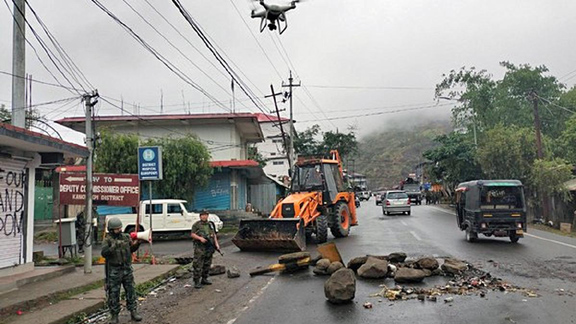
As suspicion and distrust in Manipur run deep, returning to the status quo ante is now widely seen as amounting to a Hobson’s choice

In a press statement issued on May 12, 10 Kuki-Zo legislators of the Manipur Assembly, seven of whom belong to the ruling Bharatiya Janata Party (BJP), called for a “separate administration”. They said that the Government of Manipur tacitly supported the “unabated violence” by the majority Meiteis “against the Chin-Kuki-Mizo-Zomi hill tribals,” which has “already partitioned the State and effected a total separation from the State of Manipur.” Not surprisingly, in response, a new valley-based Meitei committee staged a rally in Thoubal on May 20 urging for protection of the State’s “territorial integrity”. Of late, media and public debates have centered around the “sacrosanctity” and “inviolability” of borders.
The demands for a separate administration and for the protection of the territorial integrity of Manipur override the differences within and across the segmented Kuki-Zo and Meitei societies. The road to a separate administration will naturally be a bumpy one. And despite the grandstanding of the Biren Singh-led BJP government and the position taken by Meitei frontal organizations on the “inviolability” of borders, effecting a change of Manipur’s border lies outside the exclusive preserve of the State. For, it is Article 3 of the Constitution that gives unilateral power to the Centre on a State’s border change.
A popular demand
The central question then is: how will this demand for a separate administration constitute a critical juncture in effecting or resisting border change? The answer is that this demand enjoys unprecedented popular support among the Kuki-Zo groups. Earlier demands by tribal communities for a separate administration in the form of a Union Territory or a Territorial Council or the Sixth Schedule were what the report of the National Commission to review the working of the Constitution, constituted by the BJP-led National Democratic Alliance government in 2000, called “non-serious” as they did not have popular support. Also given dissension within and across different segments of the Kuki-Zo groups in the past, a sustained mobilization for a separate administration remained elusive. Now, faced with a common antagonistic “other,” whose position on this demand is not likely to change in the short term, popular support for this edition of the demand for a separate administration is likely to be sustained and gain more political traction.
Thus, this moment may well constitute a critical juncture in the demand by Kuki-Zo groups for a separate administration. The extensive erasure of lives and land titles, destruction of property, and the unprecedented displacement of the population across the hills and the valley suggest that the Rubicon of living under one political roof has already been crossed. As suspicion and distrust in Manipur run deep, returning to the status quo ante is now widely seen as amounting to a Hobson’s choice. Given that the violence and ethnic cleansing unleashed against both sides of the divide since May 3 has resulted in complete “demographic” and “geographical separation,” to borrow from what W.L. Hangshing, the general secretary of the Kuki People’s Alliance, told The Wire, the demand for a separate administration has become a fait accompli.
Shifting of constitutional gears
This may require a radical shifting of constitutional gears. Three possible institutional architectures are plausible. The first is to grant a separate administration in the hill areas of Manipur for not only the Kuki-Zos, but also the Nagas. The roadblocks to this are the reluctance of some Naga groups to compromise on their expansive territorial project under the rubric of a sovereign ‘Nagalim’ and the staunch opposition by the State and Meitei groups.
The second is to grant a separate administration for the Kuki-Zo in districts where they are dominant, and resolve the Naga’s demand in due course. Invoking administrative convenience and economic viability, the two cardinal principles of State reorganization in India, as counterpoints against this demand may not work in this case. This is because the institutional and administrative blueprints for this have already been laid down by the extant sub-State constitutional arrangements under the Manipur (Hill Areas) District Councils Act, 1971, where the territorial boundaries of District Councils broadly overlap with ethnic boundaries. In 2016, seven new districts were created out of the existing nine districts in Manipur, which further sharpened this overlap.
Given that Pherzawl and Churachandpur, the two districts where the majority are Kuki-Zo, sit on a rich natural gas belt (the Assam-Arakan basin), effective exploration and harnessing of these resources may offset any counter argument about the economic non-viability of this demand for a separate administration. The Kuki-Zo-dominated districts have two important strategic gateways to Southeast Asia (Behiang and Moreh). This makes the demand for a separate administration a compelling economic proposition. The challenges to this blueprint are districts such as Chandel, Kamjong and Tengnoupal, which are marked by a mixture of populations and have seen long-standing territorial disputes between the Kukis and the Nagas. However, this may not be insurmountable if a combination of territorial and non-territorial autonomy is crafted in the future.
The third possibility is to maintain the status quo ante where the territorial integrity of Manipur is secured. Given the increasingly hardened integrationist position taken by the State and frontal Meitei groups, this may entail dissolution of extant sub-State constitutional asymmetrical arrangements under Article 371C, the district councils and tribal land rights. This will, of course, require not only amendment of the Constitution, but also a revisit to the normative and political foundations of Manipur. The position of the Kuki-Zo groups, to no longer accept the powerless sub-State constitutional asymmetrical arrangements or any political solution within the existing State of Manipur, suggests that this impasse is likely to continue.
This means that Manipur will remain a deeply divided society. If the experience of other such societies including Belgium, Canada, the Netherlands, and Switzerland are to be used as any guide, the holding together of federal polity or polities requires genuine recognition and accommodation of territorially mobilized groups — not as a matter of strategic convenience of the majority but as a matter of enduring value. The reluctance to do this and the lack of democracy and federalism in East European states in the 1990s had led to state break-ups which Manipur may not like to emulate.
The jury is out
The debates to protect the territorial integrity of Manipur are likely to lead to spawn a competing constellation of agendas, ideas and interests without any immediate resolution. Or these may align in complex ways to effect or resist change in the State’s border. This is likely to resuscitate the point that defenders of the rights of States and democracy, such as K.T. Shah, raised during the Constituent Assembly debates against Article 3, which B.R. Ambedkar envisaged as a flexible and democratic constitutional provision. Shah argued that to “place power and authority in the Centre” to effect a change of State boundaries without requiring the “consent” of the said States would amount to “the serious prejudice not only of the Units, but even of the very idea of democracy.” In their overweening ambition to protect the rights of States and democracy, Shah and others forgot what K. Santhanam, another influential member, cautioned, that mandating “consent” of the States would leverage “absolute autocracy of the majority in every province and State” when they vote down a minority’s demand for merger with an adjacent State or for formation of a separate State of their own.
This debate continues to remain unresolved. The jury is out on whether the constellation of agendas, ideas and interests of multiple actors across India’s multi-level federal polity and processes align to foster institutions which protect the “absolute autocracy of the majority” or promote and accommodate the rights of territorially mobilized minority groups within and across Indian States.
(The author is Professor and Head, Department of Political Science, University of Hyderabad, and Senior Fellow of the Centre for Multilevel Federalism, Institute of Social Sciences, New Delhi. Views are personal)





Be the first to comment